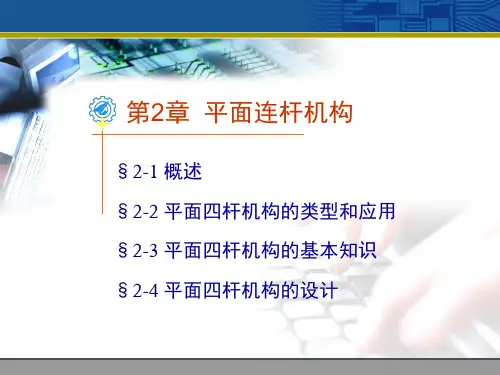第五章平面连杆机构动力分析
- 格式:doc
- 大小:1012.50 KB
- 文档页数:17
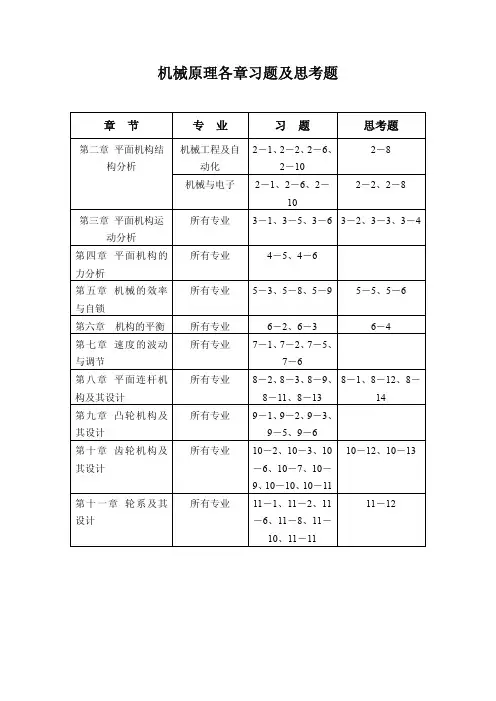
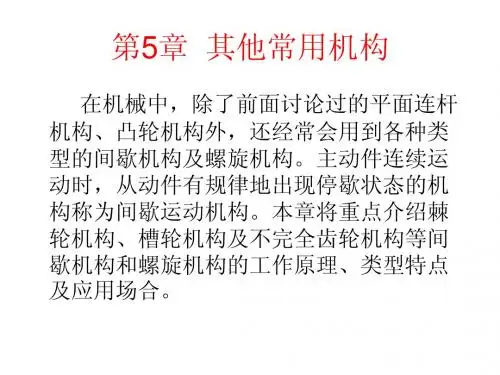
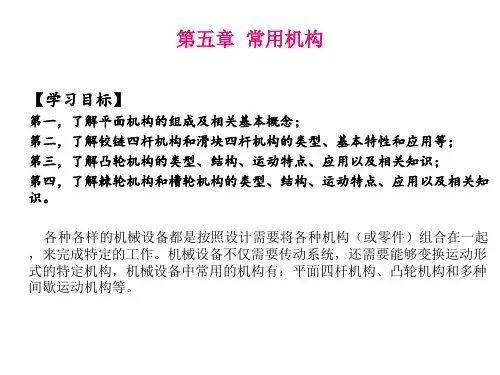

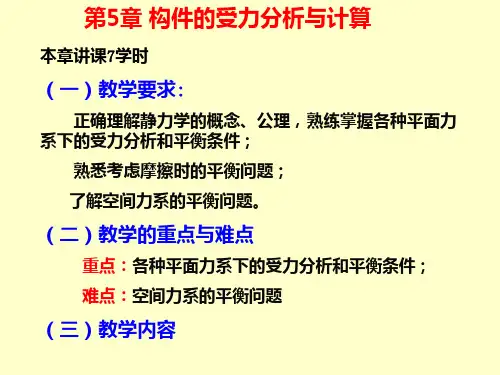
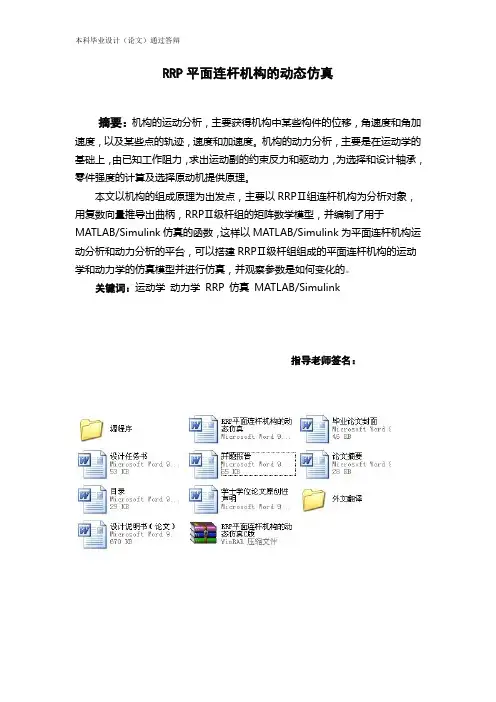
RRP平面连杆机构的动态仿真摘要:机构的运动分析,主要获得机构中某些构件的位移,角速度和角加速度,以及某些点的轨迹,速度和加速度。
机构的动力分析,主要是在运动学的基础上,由已知工作阻力,求出运动副的约束反力和驱动力,为选择和设计轴承,零件强度的计算及选择原动机提供原理。
本文以机构的组成原理为出发点,主要以RRPⅡ组连杆机构为分析对象,用复数向量推导出曲柄,RRPⅡ级杆组的矩阵数学模型,并编制了用于MATLAB/Simulink仿真的函数,这样以MATLAB/Simulink为平面连杆机构运动分析和动力分析的平台,可以搭建RRPⅡ级杆组组成的平面连杆机构的运动学和动力学的仿真模型并进行仿真,并观察参数是如何变化的。
关键词:运动学动力学 RRP 仿真 MATLAB/Simulink指导老师签名:Dynamic Simulation of RRP Planar LinkageAbstract:Analyzing the movement of institutions, mainly obtain displacement, velocity and Angle acceleration, and some points trajectory, speed and acceleration in some institutions of displacement。
Organization of the dynamic analysis of kinematics, mainly in, on the basis of the known by the work resistance, the motion pair constraint force and driving force for the selection and design of bearings, strength calculation, and select engine provide principle.This is Based on the principles of the institution as a starting point,with RRP Ⅱgroup of linkage mechanism mainly,use the plural vector derivation the Matrix mathematic model of Ⅱlevel. RRP pole ,crank.And prepare the Simulation of function of MATLAB/Simulink .So ,MATLAB/Simulink is used for platform of planar linkage mechanism.This can build RRP Ⅱ level rod group composed of planar linkage mechanism of the kinematics and dynamics simulation model and simulation.And observed how is the change of parameters.Keyword:kinematics dynamic RRP simulation MATLAB/SimulinkSignature of Supervisor:目录RRP平面连杆机构的动态仿真 ........................... 错误!未定义书签。
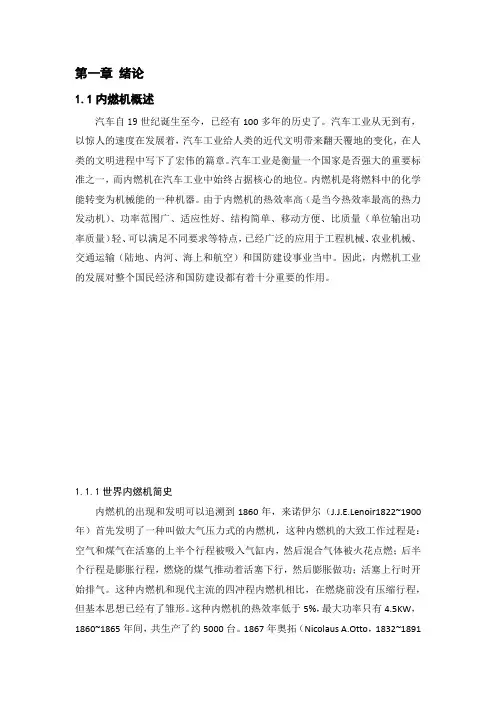
第一章绪论1.1内燃机概述汽车自19世纪诞生至今,已经有100多年的历史了。
汽车工业从无到有,以惊人的速度在发展着,汽车工业给人类的近代文明带来翻天覆地的变化,在人类的文明进程中写下了宏伟的篇章。
汽车工业是衡量一个国家是否强大的重要标准之一,而内燃机在汽车工业中始终占据核心的地位。
内燃机是将燃料中的化学能转变为机械能的一种机器。
由于内燃机的热效率高(是当今热效率最高的热力发动机)、功率范围广、适应性好、结构简单、移动方便、比质量(单位输出功率质量)轻、可以满足不同要求等特点,已经广泛的应用于工程机械、农业机械、交通运输(陆地、内河、海上和航空)和国防建设事业当中。
因此,内燃机工业的发展对整个国民经济和国防建设都有着十分重要的作用。
1.1.1世界内燃机简史内燃机的出现和发明可以追溯到1860年,来诺伊尔(J.J.E.Lenoir1822~1900年)首先发明了一种叫做大气压力式的内燃机,这种内燃机的大致工作过程是:空气和煤气在活塞的上半个行程被吸入气缸内,然后混合气体被火花点燃;后半个行程是膨胀行程,燃烧的煤气推动着活塞下行,然后膨胀做功;活塞上行时开始排气。
这种内燃机和现代主流的四冲程内燃机相比,在燃烧前没有压缩行程,但基本思想已经有了雏形。
这种内燃机的热效率低于5%,最大功率只有4.5KW,1860~1865年间,共生产了约5000台。
1867年奥拓(Nicolaus A.Otto,1832~1891年)和浪琴(Eugen Langen,1833~1895年)发明了一种更为成功的大气压力式内燃机。
这种内燃机是利用燃烧所产生的缸内压力,随着缸内压力的升高,在膨胀行程时加速一个自由活塞和齿条机构,他们的动量将使得缸内产生真空,然后大气压力推动活塞内行。
齿条则通过滚轮离合器和输出轴相啮合,然后输出功率。
这种发动机的热效率可以达到11%,共生产了近5000台。
由于煤气机必须使用气体燃料,而当时的气体燃料的来源非常困难,这从某种意义上讲就阻碍了煤气机的进一步发展。
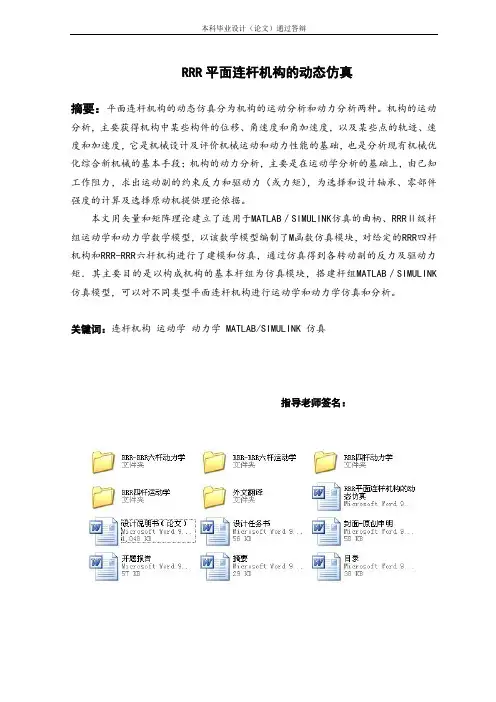
本科毕业设计(论文)通过答辩RRR平面连杆机构的动态仿真摘要:平面连杆机构的动态仿真分为机构的运动分析和动力分析两种。
机构的运动分析,主要获得机构中某些构件的位移、角速度和角加速度,以及某些点的轨迹、速度和加速度,它是机械设计及评价机械运动和动力性能的基础,也是分析现有机械优化综合新机械的基本手段;机构的动力分析,主要是在运动学分析的基础上,由已知工作阻力,求出运动副的约束反力和驱动力(或力矩),为选择和设计轴承、零部件强度的计算及选择原动机提供理论依据。
本文用矢量和矩阵理论建立了适用于MATLAB/SIMULINK仿真的曲柄、RRRⅡ级杆组运动学和动力学数学模型,以该数学模型编制了M函数仿真模块,对给定的RRR四杆机构和RRR-RRR六杆机构进行了建模和仿真,通过仿真得到各转动副的反力及驱动力矩.其主要目的是以构成机构的基本杆组为仿真模块,搭建杆组MATLAB/SIMULINK 仿真模型,可以对不同类型平面连杆机构进行运动学和动力学仿真和分析。
关键词:连杆机构运动学动力学 MATLAB/SIMULINK 仿真指导老师签名:本科毕业设计(论文)通过答辩Dynamic Simulation of RRR Planar LinkageAbstract: Dynamic simulation of planar linkage is divided into two types of kinematic analysis and dynamic analysis. The Kinematic analysis, which is the basis of the mechanical design, evaluation of mechanical motion and the dynamic performance, and it is the basic of Analyze Optimal Synthesis of new machinery of existing machinery. the main access to institutions of certain components of the displacement, angular velocity and angular acceleration, and some points of track, speed and acceleration. The Dynamic Analysis, which provides a theoretical basis for Selecting and designing of bearings, parts strength calculation and selection of the original motivation, Constraints derived anti-vice campaign and the drive force (or torque) based on the analysis of kinematics and the Working resistance.In this paper, using vector and matrix theory applicable to the MATLAB / SIMULINK simulation of the crank, RRR Ⅱ class bar group mathematical model of kinematics and dynamics, and using this mathematical model draw up M Function Simulation Module, a RRR four -bar linkage and a RRR-RRR six institutions were taken as example ,the procedures of modeling and simulating. Obtain the deputy of the anti-rotation force and driving torque through the simulation. Its main purpose is to constitute the body of the bar group Simulation Module, building the MATLAB / SIMULINK simulation model for the bar group, to do the kinematic and dynamic simulation and analysis for different types of planar linkage.Keyword: Linkage Kinematics Dynamics MATLAB/SIMULINK SimulationSignature of Supervisor:目录1 绪论1.1选题的依据及意义 (3)1.2国内外研究概况及发展趋势 (3)1.3研究内容及实验方案 (6)2 曲柄、RRRⅡ级杆组的MTALAB运动学仿真2.1用MATLAB实现牛顿-辛普森求解 (7)2.2用MATLAB进行速度分析 (6)2.3曲柄、RRRⅡ级杆组MATLAB运动学仿真模块 (7)2.4四杆机构的MATLAB运动学仿真 (12)2.5四杆机构MATLAB运动学仿真结果 (13)3 曲柄、RRRⅡ级杆组的MTALAB动力学仿真3.1曲柄、RRRⅡ级杆组MATLAB动力学仿真模块 (17)3.2四杆机构的MATLAB动力学仿真 (19)3.3四杆机构MATLAB仿真模型的初值确定 (23)3.4四杆机构MATLAB动力学仿真结果 (23)4 RRR-RRR六杆机构的MTALAB运动学仿真4.1 RRR-RRR六杆机构 (26)4.2 RRR-RRR六杆机构MATLAB仿真模型 (26)4.3 RRR-RRR六杆机构MATLAB真模块 (28)4.4 RRR-RRR六杆机构MATLAB仿真模块中初值的确定 (29)4.5 RRR-RRR六杆机构MATLAB运动学仿真结果 (29)5 RRR-RRR六杆机构的MTALAB动力学仿真5.1 RRR-RRR六杆机构 (35)5.2 RRR-RRR六杆机构MATLAB仿真模型 (35)5.3 RRR-RRR六杆机构MATLAB仿真模块 (37)5.4 RRR-RRR六杆机构MATLAB仿真模块中初值的确定 (38)5.5 RRR-RRR六杆机构MATLAB运动学仿真结果 (38)总结 (41)参考文献 (43)致谢 (45)1 绪论1.1选题的依据及意义平面连杆机构是许多构建用低副(转动副和移动副)连接组成的平面机构。

